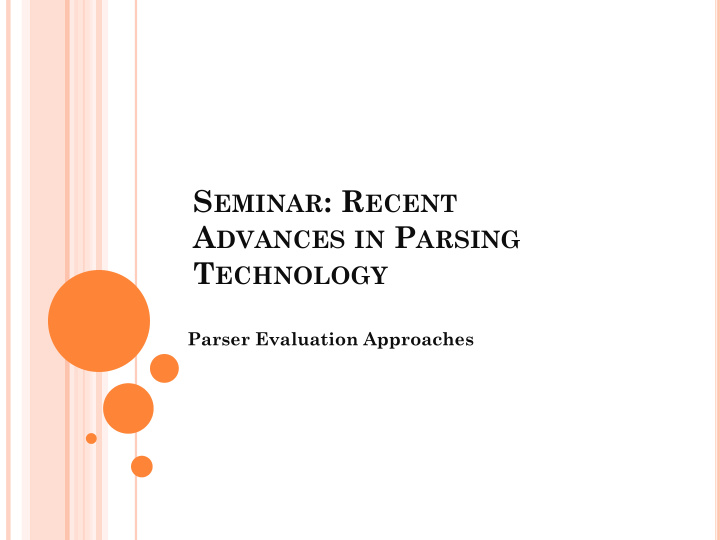



S EMINAR : R ECENT A DVANCES IN P ARSING T ECHNOLOGY Parser Evaluation Approaches
N ATURE OF P ARSER E VALUATION Return accurate syntactic structure of sentence. Which representation? Robustness of parsing. Quick Applicable across frameworks Evaluation based on different sources. E.g Evaluation too forgiving for same training and testing test
P ARSER EVALUATION Intrinsic Evaluation Extrinsic Evaluation Test parser accuracy Test accuracy of the independently as “ a parser by evaluating its stand- alone” system. impact on a specific Test parser output NLP task.(Molla & along Treebank Hunchinson 2003) annotations. Accuracy along BUT: High accuracy on frameworks and tasks. intrinsic evaluation does not guarantee domain portability.
P ARSER EVALUATION Intrinsic Evaluation Extrinsic Evaluation NLU-Human Comp PennTreebank Interaction Systems. training & parser IE Systems (PETE). testing PPI PARSEVAL metrics And more . . . PSR Bracketings LA, LR, LAS-UAS for dependency Parsing
T ASK - ORIENTED E VALUATION OF S YNTACTIC P ARSERS & R EPRESENTATIONS Miyao,Saetre,Sagae,Matsuzaki,Tsujii(2008),Procee dings of ACL
PARSER EVALUATION ACROSS FRAMEWORKS Parsing accuracy can’t be equally evaluated due to: Multiple Parsers Grammatical Frameworks Output representations: Phrase-Strucure Trees, Dependency Graphs, Predicate Argument Relations. Training and testing along the same sources e.g: WSJ .
Dependency PS Parsing Parsing Dependency Parsing Evaluation?
T ASK - ORIENTED APPROACH TO PARSING EVALUATION G OAL Evaluate different syntactic parsers and their representations based on a different methods. Measure accuracy by using an NLP task: PPI(Protein Protein Interaction).
MST KSDEP NO-RERANK RERANK BERKLEY STANFORD ENJU ENJU-GENIA PPI Extraction task Conversion of representation s OUTPUTS Statistical features in ML classifier
W HAT IS PPI? I Multiple techniques employed for PPI. effectiveness of Dependency Parsing • Automatically detecting interactions between proteins. • Extraction of relevant information from biomedical papers. • Developed in IE Task.
W HAT IS PPI? II (A) <IL-8, CXCR1> (B) <RBP, TTR>
PARSERS & THEIR FRAMEWORKS * Dependency Parsing: MST: projective dep parsing KSDEP:Prob shift-reduce parsing. Phrase Structure Parsing: NO-RERANK: Charniak’s (2000), lexicalized PCFG Parser. RERANK: Receives results from NO-RERANK & selects the most likely result. BERKLEY: STANFORD: Unlexicalized Parser
PARSERS & THEIR FRAMEWORKS Deep Parsing Predicate-Argument Structures reflecting semantic/syntactic relations among words, encoding deeper relations. ENJU: HPSG parser and extracted Grammar from Penn Treebank. ENJU-GENIA: Adapted to biomedical texts GENIA
C ONVERSION SCHEMES Convert each default parse output to other possible representations. CoNLL: dependency tree format, easy constituent-to- dependency conversion. PTB: PSR Trees output HD: Dep Trees with syntactic heads . SD: Stanford Dependency Format HD SD PAS: Default output of ENJU & ENJU GENIA
C ONVERSION SCHEMES 4 Representations for the PSR parsers. 5 Representations for the deep parsers.
D OMAIN P ORTABILITY All versions of parsers run 2 times. WSJ(39832) original source GENIA(8127): Penn treebank style corpus of biomedical texts. Retraining of the parsers with GENIA* to illustrate domain portability , accuracy improvements domain adaptation
EXPERIMENTS Aimed corpus 225 biomedical paper abstracts
EVALUATION RESULTS Same level of achievement across WSJ trained parsers.
EVALUATION RESULTS
EVALUATION RESULTS Dependency Parsers fastest of all. • Deep Parsers in between speed. •
DISCUSSION
F ORMALISM I NDEPENDENT P ARSER E VALUATION WITH CCG & D EP B ANK
DEPBANK Dependency bank, consisting of PAS Relations. Annotated to cover a wide selection of grammatical features. Produced semi-automatically as a product of XLE System Briscoe’s& Caroll(2006) Reannotated DepBank Reannotation with simpler GRs. Original DepBank annotations kept the same.
GOAL OF THE PAPER Perform evaluation of CCG Parser outside of the CCG bank. Evaluation in DepBank . Conversion of CCG dependencies to Depbank GRs. Measuring the difficulty and effectiveness of the conversion. Comparison of CCG Parser against RASP Parser.
CCG PARSER Predicate- Argument dependencies in terms of CCG lexical categories. “IBM bought the company” <bought, (S/ 𝑂𝑄 1 )/ 𝑂𝑄 2 , 2 company, - >
MAPPING OF GR S TO CCG DEPENDENCIES Measuring the difficulty transformation from one formalism to other
MAPPING OF GR S TO CCG DEPENDENCIES 2 nd Step Post Processing of the output by comparing CCG derivations corresponding to Depbank outputs . Forcing the parser to produce gold-standard derivations. Comparison of the GRs with the Depbank outputs and measuring Precision & Recall. Precision : 72.23% Recall: 79.56% F-score:77.6% Shows the difference between schemes. Still a long way to the perfect conversion
EVALUATION WITH RASP PARSER
Recommend
More recommend